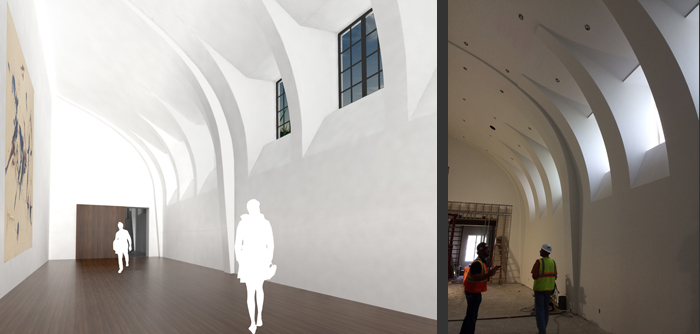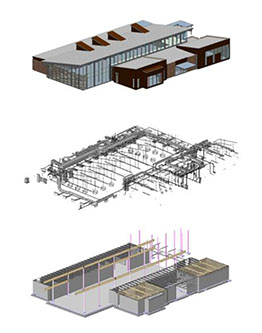ALLISON
PARTNERS
+
Your Partner in Creating Lasting Places
Construction Documents 101
May 20, 2015

Faulkner Performing Arts Center Rendering (left) and Construction Photo (right) of Side Lobby.
Project in association with HGA Architects.
Clear and conscientious construction documentation is a critical aspect in the practice of Architecture for several reasons. First, this will set the tone for the contractor that will resonate from issuing the bid documents and the first pre-construction meeting through to substantial completion. Second, a well-documented project is less likely to have surprise costs during construction. Lastly, with well-detailed construction documentation, the construction process will go much smoother.
To explain, construction documents are the written and graphic instructions used for the construction of a project. This includes specifications and other written documents that make up the project manual, plus construction drawings. This article focuses on a few tools that architects can utilize to aid in the production of clear and concise drawings.
One tool at the Architect’s disposal is Building Information Modeling (BIM). BIM is a process of drawing a building though the use of sophisticated 3D software. All design consultants are required to provide an accurate 3D model for their trade. In order to provide a successful outcome, the design team shares their models and coordinates often to discuss modifications that necessary to accommodate client alterations, aesthetics, building systems, and structure. Each team member is required to be flexible so that the overall vision of the design can be fulfilled. A full time BIM coordinator may be essential to review each aspect of the design, based on the complexity of the project.

Revit BIM models of Oley E. Rooker Library, showing Architectural model (top), Mechanical, Electrical, Plumbing model (middle), and Structural model (bottom).
Another tool that is available to the Architect to help assemble the construction documents is design team coordination meetings. Structural, mechanical, pluming, electrical and civil engineers, to name a few, all play roles in the development of any building project. There may be additional consultants required based on the building typology. The design team is required have clear communication avenues throughout the duration of project documentation. Also, having scheduled meetings to review the documents at each phase of design is most beneficial. Each consultant will submit their work, at each phase, to the Project Architect for review. The Project Architect is responsible for insuring that all design team members are working together to coordinate building elements and systems to form a holistic result. After the review has taken place, the team will have a coordination meeting to discuss progress, intentions, and any conflicts that may have arisen while in production. These items will be discussed with the entire design team to make sure all are on the same page.
Designing timeless and thoughtful buildings takes practice, and the documentation, which relays those ideas to the contractor, is arguably the most important aspect of Architecture. Inconsistencies in the documents that are discovered once construction has begun may be more costly than if the solution was originally included in the construction documents. A well-documented project with thoughtful layout and precise drawings will relay the architect and owner’s expectations for the project. It will demonstrate to the contractor that the design team has carefully orchestrated the design through its documentation.

Mark Horne, AIA
mhorne@allarch.com
Mark joined Allison Architects' Northwest Arkansas Office in February of 2013. He has worked on a variety of projects from master planning and healthcare to educational and institutional in different regions of the country including New York City and The District of Columbia. Mark has experience providing conceptual 3D modeling and visualization throughout the various phases of projects using BIM software. With a background in construction, his technical knowledge helps to create a successful project.
Next Post
Blog Home Page
Previous Post